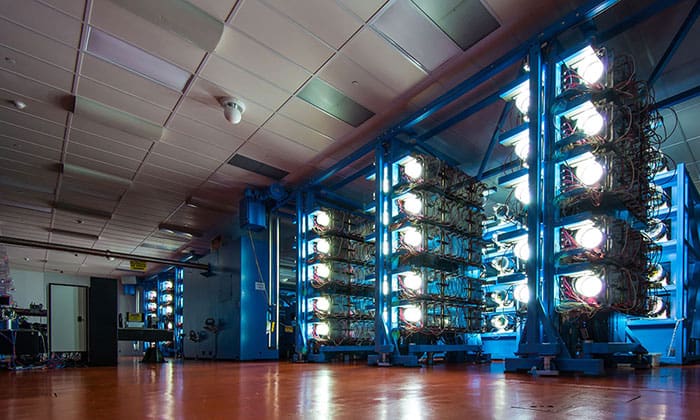Flash Physics is our daily pick of the latest need-to-know developments from the global physics community selected by Physics World‘s team of editors and reporters

Crisply imaging a single ion
A novel imaging technique that can capture a single atomic ion and its motion with unprecedented nanoscale sensitivity has been unveiled by researchers at the Joint Quantum Institute in the US. This adaptive-optics method uses a combination of high-performance lenses and computer processing to get rid of aberrations and distortions that lead to image inaccuracies. The team says that its imaging system was able to detect ion movements on the scale of a few nanometres and could be used to measure quantum superpositions of two different motional states of a single ion. It may also have applications in other fields that include point-like sources, such as biology and astronomy. The work is published in Nature Photonics.
Coherently coupling spins to a nitrogen vacancy
Researchers have coherently coupled three spins to a nitrogen vacancy and the system could have applications in building quantum sensors and simulations. Normally, physicists try to avoid coupling diamond nitrogen vacancies (NVs) to nearby electron spins because this causes decoherence and makes the NVs unsuitable for storing quantum information. But now, Helena Knowles, Dhiren Kara, and Mete Atatüre of the University of Cambridge have stored and read out quantum information using an NV that is coherently coupled to three nearby spins. Possible applications of the system include measuring extremely small magnetic fields in living organisms and building quantum simulators on a chip. The work is described in Physical Review Letters.
Large Hadron Collider hits luminosity target
Last week, the Large Hadron Collider at the CERN particle-physics lab in Geneva hit a new milestone as the integrated luminosity delivered to its ATLAS and CMS detectors reached 25 fb–1 – the lab’s target for the whole of 2016. LHC researchers have been hard at work all year round to develop new ways to boost the device’s performance and thanks to the improvements, the LHC was routinely operated with peak luminosities 10%–15% above the design value of 1034 cm–2 s–1 in July and August. This success was achieved despite an unexpected animal incident involving a small beech martin in May and a control fault in the cryogenics plant in August that meant that the ATLAS experiment had to ramp down its magnets, requiring five days to get back to normal conditions. The accelerator team is now preparing for the “season finale”, where forward proton–proton physics and proton–lead physics will replace the familiar proton–proton physics.

OMEGA laser sets new fusion-yield record
Scientists working on the OMEGA laser at the University of Rochester have created the conditions capable of producing a fusion yield that’s five times higher than the current record – as long as their results can be scaled up to work at the National Ignition Facility (NIF) at the Lawrence Livermore National Laboratory in California. The OMEGA laser was used to fire 60 laser beams directly at a millimetre-sized fuel pellet. Their results show that if their “direct-drive” method of fusion can be replicated at NIF – which instead uses “indirect-drive”, where the light from 192 laser beams is first converted into X-rays before hitting the fuel capsule – then it would be possible to produce more than 100 kJ of fusion energy, bringing the facility nearer to its “ignition” target.
UK “supercouncil” will boost research and industry collaboration, says science minister
Plans to merge Innovate UK with the UK’s research councils (RCUK) to create a “supercouncil” of UK research and innovation will allow the UK to “exploit the knowledge and expertise we have for the benefit of the whole country”, according to a letter written by science minister Jo Johnson and presented to the House of Lords Science and Technology Committee. According to Johnson, such a merger will remove the barriers between research and businesses. Johnson’s letter was in response to one of his peers on the committee, who had earlier expressed “serious concerns” about the merger plans, which are a part of the higher-education and research bill that is currently passing through the Commons.
- You can find all our daily Flash Physics posts in the website’s news section, as well as on Twitter and Facebook using #FlashPhysics. Tune in to physicsworld.com later today to read today’s extensive news story on creating a piezoelectric generator from fish scales.



